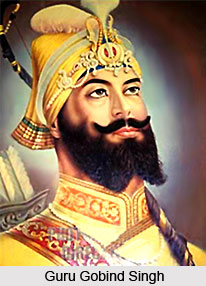 Militarism under Sikhs was a well organised and maintained aspect. It was Guru Gobind Singh who put the Sikhs on the military history of the country and as such has rightly been called the father of Sikh militarism. Determined to revenge for the large scale tortures and repressions on his followers, Gobind Singh by a slow process of renunciation and training consolidated all the fragments of the Sikh military system and converted it into a powerful force. Gobind Singh`s contributions to the cause of Sikh religion are tremendous. With all the militarism of his times and all that followed afterwards Sikhism remained primarily a religious code. Several elementary principles had been adopted by Guru Gobind Singh regarding militarism. It is claimed that the forces under the Sikhs in 1764 numbered near about 50,000. A chain of forts was built at a few strategic sites. Cavalry was their main arm as everything depended upon mobility during a campaign. Infantry was used to man forts. In April 1765 the Sikhs again occupied Lahore and the whole of the Punjab province was partitioned amongst the various chiefs.
Militarism under Sikhs was a well organised and maintained aspect. It was Guru Gobind Singh who put the Sikhs on the military history of the country and as such has rightly been called the father of Sikh militarism. Determined to revenge for the large scale tortures and repressions on his followers, Gobind Singh by a slow process of renunciation and training consolidated all the fragments of the Sikh military system and converted it into a powerful force. Gobind Singh`s contributions to the cause of Sikh religion are tremendous. With all the militarism of his times and all that followed afterwards Sikhism remained primarily a religious code. Several elementary principles had been adopted by Guru Gobind Singh regarding militarism. It is claimed that the forces under the Sikhs in 1764 numbered near about 50,000. A chain of forts was built at a few strategic sites. Cavalry was their main arm as everything depended upon mobility during a campaign. Infantry was used to man forts. In April 1765 the Sikhs again occupied Lahore and the whole of the Punjab province was partitioned amongst the various chiefs.
The Sikh alliance consisted of twelve misls - Bhangi; Nakkai; Sukerchukia; Nishania; Ahluwalia; Shahid; Singhpooria; Kanheya; Ramgharia; Dullewalia; Krore Singha and Phoolkia. Each misl had one leader, one langar and one administration. Some of the names of the misls were derived from their leaders. Some of them were really very powerful with as many as 20,000 and more armed followers. Thus, during this period from the fall of Banda in 1716 up to the establishment of a Sikh state in 1765 was full of brilliant achievements by a few men under the banners of the Khalsa. Privations and defeats were many. Accompanied by so much of convincing fanfare and backed by downright commonsense the new system had tremendous effect on all. Even the out-casts who joined up became good soldiers. Those admitted into Sikhism from the lower castes were known as mazhabi Sikhs. These were enrolled much later by the English into the British East India Company`s regiments and earned a good name for themselves as savvy fighters.
The period from 1764 until the rise of Maharaja Ranjit Singh in early nineteenth century as a pivot of all Sikh activities, was again full of internal dissensions. This period also witnessed considerable increase in the power of the misls. Of the misl chiefs the Bhangis had gained great prominence under Hari Singh and held Lahore, Amritsar and areas north of it. The Sukerchukias, under Maha Singh were another strong misl with their centre at Gujranwala. Their influence extended between the Chenab River and Ravi River. Soon they gained the upper hand and annexed the Kanheya dominions between Amritsar and the hills.




















